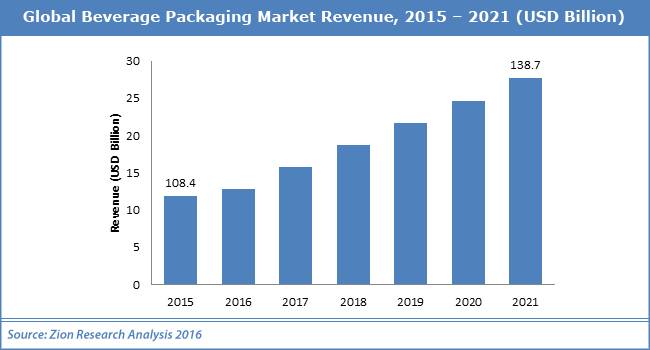The global beverage packaging market, valued at over US$186 bln in 2015, is expected to increase at a compound annual growth rate of over 3% through 2020 and beyond, as per Future Markets Insights. In the backdrop of innovation in packaging techniques, beverage companies are able to experiment with their packaging, enhancing their functionality and sustainability.
Plastic bottles are becoming more ubiquitous by the day owing to their advantages over glass bottles. Choosing plastic over glass is an easy decision for manufacturers looking to reduce weight, speed up transportation, and reduce packaging costs. Polyethylene terephthalate (PET) bottles are expected to witness steady demand from end-use sectors during the forecast period 2015-2025. Beverage packaging has relied upon the mass production model for years; however, as consumer aspirations shift to personalisation and greater customisation, brands are adopting collaborative design ideas to cater to the shifting trends. Co-creation is gathering steam in the beverage packaging landscape, with Coca Cola and Nutella collaborating with consumers to create the packaging that they desire. Packages designed for one-person households are gaining traction as the percentage of one-person households continue to increase in key, lucrative markets. During the forecast period, multipacks of individual portions will include a significant revenue share of the global beverage packaging market.
The next-generation packaging market, valued at over US$32 bln in 2015, will witness steady increase in global revenues, and reach US$58 bln by 2025. Active packaging, intelligent packaging, and modified atmosphere packaging are expected to gain adoption among end-users. Asia Pacific (excluding Japan) and North America will continue to be the two largest markets for beverage packaging globally, closely followed by Western Europe. The beverage packaging market in APEJ will continue to witness steady gains during the forecast period. Accounting for a revenue share of over 25% in 2015, the APEJ market will continue to offer growth opportunities to existing and new entrants, as the beverage industry in the region witnesses a period of progression. Among all the regions, the market will witness fastest gains in APEJ.
CSD/soda will continue to account for highest revenue share by application segmentation. Other key application segments in the beverage packaging market include dairy and juice/soft drinks. Among all the application segments, demand for plastic packaging is higher than glass bottles and cans. In the CSD/soda packaging segment, plastic packaging accounted for a market value of nearly US$37 bln in 2015, compared to US$12 bln worth of cans and US$5.4 bln worth of glass bottles.
VisionGain评估了全球饮料包装市场将在2016年产生112.4美元的收入。饮料包装市场将在未来10年内增长,价格相当稳定。由于未来十年的财务和地缘政治气候,全球增长将保持不变。商品价格降低以及中国经济的放缓将对全球生产产生重大影响。但是,鉴于当前世界各地的地缘政治紧张局势,GDP的增长将保持适中,但在未来几年内保持稳定。然而,有许多因素权衡饮料包装技术及其增长轨迹的发展。人口不断增长,新兴经济体的经济发展,从商品驱动的经济体转变为消费者驱动的经济体,全球可持续性问题和其他因素将有助于行业的发展。主要因素之一是近年来观察到的原油价格较低,这导致塑料包装材料制造商的利润更高。此外,消费者的生活方式转移到方便的方面,将趋势定义为基于单一或部分包装而不是标准包装的趋势。
关键趋势之一是人口的增加,因为对食品和饮料的需求将在未来10年内更高,因此对饮料包装的需求将相应地增长。该人群的位置还将对未来的饮料包装市场产生重大影响。全球城市化越来越多,尤其是在印度和中国等新兴经济体中正在加速。这意味着将需要更多的便利产品,因为这些消费者受到更多时间的限制,因此对包装商品的需求将增加,这也意味着饮料。除此之外,随着这些新兴市场的发展和增长,将有更多的中产阶级消费者具有更高的可支配收入,并且对溢价饮料的需求也会增加,因此对饮料包装的需求再次增加。
根据锡安的研究,全球对饮料包装市场的需求在2015年的价值为108.4美元,预计将在2021年达到138.7美元,预计将在2016年至2021年之间以4.2%的复合年增长率增长。包装起着重要的作用。在饮料行业。熟练的包装解决方案提供了优势,例如可用性,易用性和改进的用户体验。这些优势导致饮料包装解决方案的需求增加。包装的主要目的是保护,保护和推广产品。
Beverage packaging market is directly proportional to growing demand for various types of beverages. Beverage packaging market is driven by several factors like increase in beverage consumption, and the growing demand for long shelf life of the product. Lightweight packaging material has become an essential factor in the market and having significant influence in beverage bottles and cans segment. This is further driven by environmental pressures from government, and low material usage for packages means low costs, which are always beneficial for both brands and retailers. Moreover, stringent government regulation for environmental safety may affect the market growth.

On the basis of packaging type market is divided into bottles, cans, pouch, and carton. Bottles and cans represented the significant share in global beverage packaging market. The material segment includes glass, plastic, metal, and paperboard. Plastic continue to represent the highest growing beverage packaging material due to rising consumer demand and portability. Alcoholic, non-alcoholic, and dairy are key application segment of beverage packaging market. Beverage packaging market in Asia-Pacific is expected to show massive opportunities for market owing to rapidly growing beverage consumption in the region. Large population coupled with increasing income levels in developing economies such as China and India are expected to drive the beverage consumption in the region. Furthermore, availability of skilled workers, low cost of production and government funding are expected to further boost the market growth in the region. North America was the leading market player in 2015 owing to the presence of a large number of key players in the region.
The beverage packaging market is considered to be one of the most dynamic packaging markets with shifts in types of packaging and materials used varyingly across regions. The global beverage packaging market is expected to grow from US$97.2 bln in 2012 to US$125.7 bln by 2018, according to a report from MarketsandMarkets. In the global beverage packaging market, the major types are bottle, can, pouch and cartons, in which beverages are served. Consumer preferences, product characteristics, and material compatibility are essential to determine the type of packaging.
酒精,尽管由瓶子and cans, are bound to grow in the case of alternative materials for bottling. Non-alcoholic beverage packages are witnessing a gradual increase in preference for cartons and cans. Dairy beverages are mostly served in pouches; however, flavored and drinkable yoghurt creates a demand for other forms of packages. Asia-Pacific has the highest market share and is witnessed to be the fastest-growing market. Europe’s growth is driven mainly by the East European markets. ROW is also expecting to experience growth in the beverage packaging market in future.
Dairy beverage packaging market is the fastest-growing market, with growing health concerns and knowledge about the nutrition value driving the dairy products. Non-alcoholic packaging is estimated to be the second fastest-growing market in 2013. Alcoholic packaging has the highest share, but the market has reached a maturity level and has a low growth rate as compared to the other two segments. |

{{comment.datetimestampdisplay}}}
{{comment.comments}}